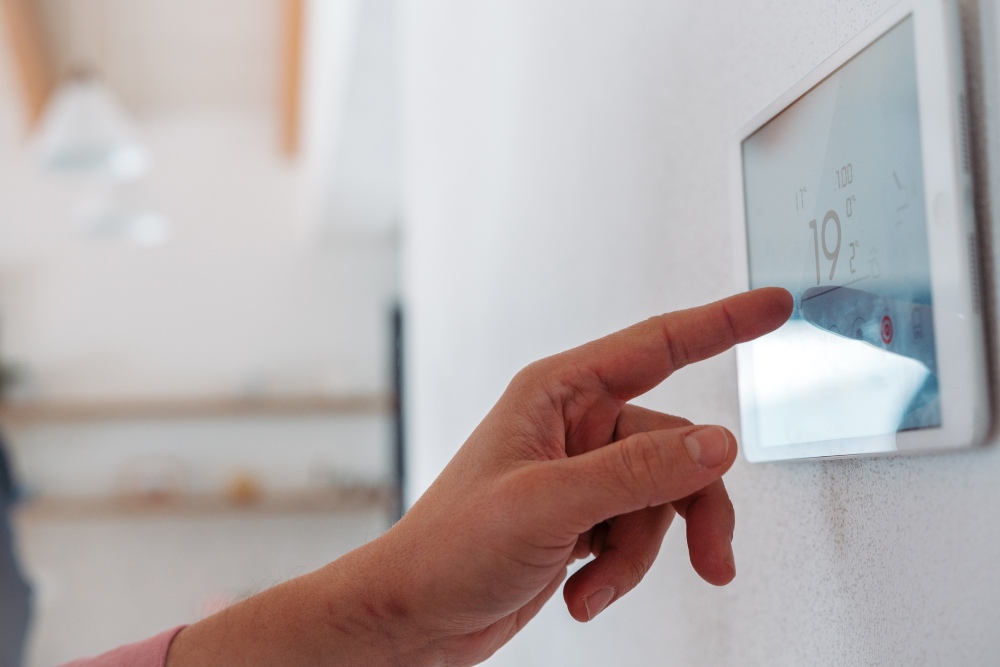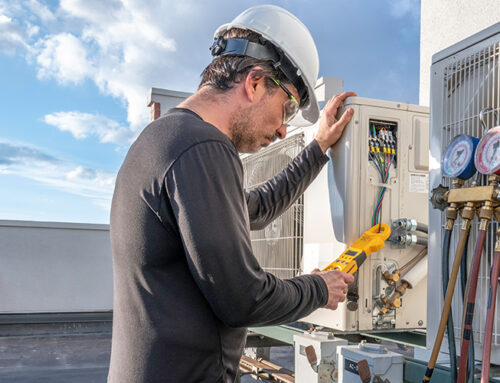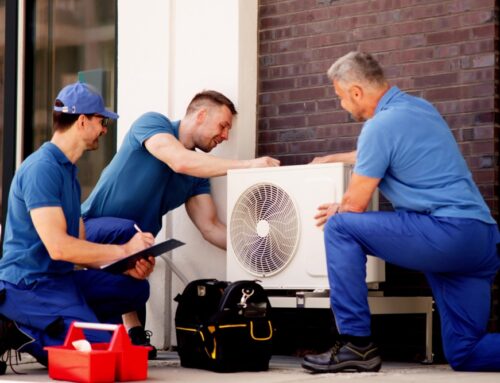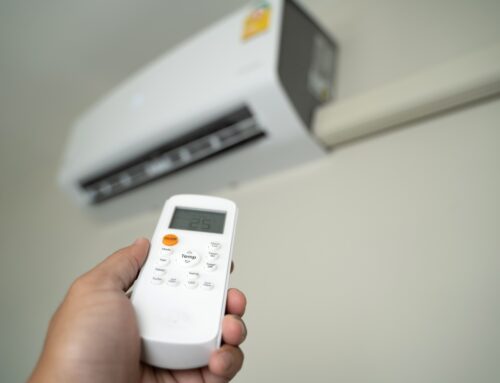The advent of smart thermostats has brought a significant transformation to the world of commercial air conditioning, offering a revolutionary approach to managing energy use and operational costs.
By integrating advanced technology with commercial HVAC systems, these programmable HVAC devices enable precise control over indoor climates, leading to enhanced comfort levels in workplaces. As businesses increasingly seek ways to improve energy efficiency and reduce expenses, smart HVAC solutions are becoming an indispensable tool.
In this comprehensive exploration, Chills AC will delve into how smart thermostats optimize energy consumption, streamline AC automation, and contribute to a more sustainable and cost-effective commercial environment.
What Are Smart Thermostats?
Smart thermostats are advanced devices designed to control heating, ventilation, and air conditioning (HVAC) systems in both residential and commercial settings. Unlike traditional thermostats, smart thermostats offer a range of features such as programmable schedules, remote access via smartphones, and integration with other smart home devices. These capabilities allow users to manage indoor temperatures more efficiently, ultimately leading to energy savings and increased comfort.
Additionally, smart thermostats often come equipped with sensors that monitor occupancy and adjust settings accordingly, ensuring optimal performance without manual intervention. In the context of commercial HVAC systems, smart thermostats play a crucial role in maintaining consistent climate conditions while minimizing energy consumption and operational costs. By leveraging data and automation, these devices enable businesses to create a more sustainable and cost-effective environment.
Evolution of Commercial HVAC
Commercial HVAC systems have undergone significant advancements over the past few decades. Initially, these systems relied on manual controls and basic thermostats to regulate indoor temperatures. However, as technology progressed, the introduction of digital and programmable thermostats allowed for more precise control and scheduling. This evolution marked a shift towards greater energy efficiency and user convenience. The latest phase in this evolution is the integration of smart thermostats, which utilize sensors, algorithms, and internet connectivity to optimize HVAC performance.
These smart HVAC solutions not only adjust temperature settings based on real-time data but also provide insights and analytics to help businesses identify inefficiencies and areas for improvement. As a result, modern commercial HVAC systems are more efficient, cost-effective, and capable of maintaining consistent comfort levels across various commercial environments.
Importance of Energy Efficiency
Energy efficiency has become a critical priority for businesses aiming to reduce operational costs and minimize their environmental footprint. In commercial settings, HVAC systems are among the largest consumers of energy, making them a key target for efficiency improvements. Enhanced energy efficiency not only translates to lower utility bills but also contributes to the overall sustainability goals of a business.
By optimizing energy consumption, companies can reduce greenhouse gas emissions and demonstrate their commitment to environmental stewardship. Smart thermostats play a pivotal role in achieving these objectives by enabling precise control over HVAC operations. Through features like programmable schedules, occupancy sensors, and real-time data analysis, these devices help ensure that energy is used only when and where it is needed.
This leads to significant cost savings and promotes a more sustainable business model, benefiting both the bottom line and the planet.
Optimizing Energy Efficiency
Real-time Energy Monitoring
Real-time energy monitoring is a significant feature of smart thermostats that revolutionizes how businesses manage their HVAC systems. By continuously tracking energy consumption, smart thermostats provide immediate insights into how and when energy is being used. This data allows facility managers to make informed decisions about optimizing HVAC operations. For instance, if the system detects that certain areas of a building are unoccupied, it can adjust the temperature settings accordingly to save energy.
Also, real-time monitoring can identify patterns in energy usage, highlighting inefficiencies or potential issues before they become costly problems. This proactive approach not only enhances energy efficiency but also extends the lifespan of HVAC equipment by preventing overuse and wear. As a result, businesses can achieve substantial cost savings while maintaining a comfortable and efficient indoor environment.
Adaptive Learning Features
Adaptive learning features are a hallmark of smart thermostats, setting them apart from traditional programmable HVAC systems. These features use advanced algorithms to learn the patterns of occupancy and temperature preferences in a commercial space. Over time, the thermostat adjusts its settings automatically to align with these patterns, ensuring optimal comfort and energy efficiency without manual intervention. For instance, if a smart thermostat detects that certain areas are frequently occupied during specific hours, it will pre-cool or pre-heat those areas accordingly.
This adaptive approach not only enhances user comfort but also reduces energy waste by avoiding unnecessary heating or cooling. Moreover, these learning capabilities can adjust to changes in occupancy or usage patterns, making the system highly responsive to the dynamic needs of a commercial environment. By leveraging adaptive learning, businesses can achieve a balance between maintaining a comfortable indoor climate and optimizing energy consumption.
Integration with Programmable HVAC
Integrating smart thermostats with existing programmable HVAC systems can significantly enhance energy management and operational efficiency. While programmable HVAC systems allow for preset schedules and basic automation, smart thermostats bring an additional layer of intelligence and flexibility. By connecting to a smart thermostat, a programmable HVAC system gains access to advanced features such as remote control, real-time energy monitoring, and adaptive learning. This integration allows businesses to fine-tune their climate control settings based on real-time data and occupancy patterns, rather than relying solely on fixed schedules.
Smart thermostats can communicate with other smart devices and building management systems, creating a cohesive and responsive environment that maximizes energy efficiency. The ability to remotely adjust settings and receive alerts also ensures that any issues can be addressed promptly, preventing energy waste and maintaining optimal indoor conditions.
Reducing Operational Costs
Lower Energy Bills
One of the most immediate and tangible benefits of using smart thermostats in commercial HVAC systems is the reduction in energy bills. By offering precise control over heating and cooling operations, smart thermostats ensure that energy is consumed only when necessary. Features such as programmable schedules, real-time energy monitoring, and adaptive learning work together to minimize energy wastage.
For instance, occupancy sensors can detect when areas are vacant and adjust the temperature settings to conserve energy. Additionally, real-time data allows facility managers to identify inefficiencies and make informed adjustments quickly. Over time, these small optimizations add up, leading to significant reductions in overall energy consumption. Consequently, businesses can experience a noticeable decrease in their monthly utility bills, freeing up resources that can be allocated to other operational needs.
Maintenance and Repair Savings
Smart thermostats contribute to reducing maintenance and repair costs for commercial HVAC systems. By continuously monitoring system performance, these devices can detect anomalies and inefficiencies early on. This proactive approach allows facility managers to address potential issues before they escalate into costly repairs. Additionally, smart thermostats can provide diagnostic data that helps technicians pinpoint the root cause of problems more quickly, reducing labor costs and downtime.
The adaptive learning and automation features also ensure that HVAC systems operate more efficiently, reducing wear and tear on components. This leads to fewer breakdowns and extends the lifespan of the equipment. Moreover, smart thermostats can send alerts and reminders for routine maintenance tasks, ensuring that the HVAC system remains in optimal condition.
Enhanced Operational Control
Enhanced operational control is another significant advantage of incorporating smart thermostats into commercial HVAC systems. These devices offer granular control over heating and cooling settings, allowing facility managers to tailor climate conditions to specific areas and times. For instance, different zones within a commercial space can be individually programmed to meet varying temperature needs, ensuring optimal comfort and efficiency. Remote access capabilities further enhance control by enabling adjustments from anywhere via a smartphone or computer.
This flexibility ensures that HVAC operations can be adapted quickly in response to changing conditions, such as unexpected occupancy or weather changes. Additionally, smart thermostats provide detailed analytics and reports on energy usage, helping managers identify trends and make data-driven decisions to improve efficiency. By offering precise and adaptable control, smart thermostats help businesses streamline their HVAC operations, reduce energy consumption, and maintain a comfortable indoor environment, all while keeping operational costs in check.
Enhancing Workplace Comfort
Personalized Temperature Settings
Personalized temperature settings are a key feature of smart thermostats that significantly enhance workplace comfort. These devices allow for the customization of temperature settings to meet the specific preferences of different zones within a commercial space. For instance, conference rooms, offices, and common areas can each have their own tailored settings, ensuring optimal comfort for everyone.
By learning occupancy patterns and individual preferences, smart thermostats can automatically adjust temperatures to create a more comfortable environment without manual intervention. This not only improves employee satisfaction but also enhances productivity, as a comfortable workspace is essential for maintaining focus and efficiency. Furthermore, the ability to control temperature settings remotely means that adjustments can be made in real-time to accommodate any changes in occupancy or usage.
Automated Climate Control
Automated climate control is another feature of smart thermostats that greatly enhances workplace comfort. By leveraging sensors and advanced algorithms, smart thermostats can automatically adjust heating and cooling settings based on real-time data. This means that the system can respond to changes in occupancy, time of day, and even external weather conditions without manual intervention. For example, if a meeting room becomes occupied, the smart thermostat can increase cooling to maintain a comfortable temperature.
Conversely, it can reduce energy usage in unoccupied areas. This automation ensures that indoor environments remain consistently comfortable while optimizing energy efficiency. Additionally, automated climate control reduces the need for constant manual adjustments, freeing up time for facility managers and employees.
Benefits of AC Automation
AC automation offers numerous benefits that significantly enhance workplace comfort and efficiency. By automating the control of air conditioning systems, businesses can ensure a consistent and comfortable indoor climate without the need for constant manual adjustments. This leads to a more stable and pleasant environment for employees, which can boost productivity and morale. Additionally, AC automation helps optimize energy use by adjusting settings based on real-time data such as occupancy, time of day, and weather conditions.
This not only reduces energy consumption and lowers utility bills but also minimizes the environmental impact. Automated systems can also quickly respond to changes, ensuring that comfort levels are maintained even during unexpected fluctuations in occupancy or temperature. Moreover, AC automation can integrate with other building management systems to provide a cohesive approach to climate control.
Overall, the benefits of AC automation make it an essential component of modern commercial HVAC solutions, promoting both comfort and efficiency.
Conclusion
Smart thermostats are revolutionizing commercial HVAC systems by enhancing energy efficiency, reducing operational costs, and improving workplace comfort. As technology continues to advance, the integration of IoT, AI, and machine learning will drive further innovations, making HVAC systems smarter and more responsive. These advancements not only contribute to a more sustainable environment but also provide significant cost savings for businesses.
If you’re looking to optimize your commercial HVAC system, now is the perfect time to explore the benefits of smart thermostats and AC automation. For expert assistance in making your commercial space more energy-efficient and comfortable, consider the services offered by Chills AC.
Our team of professionals can help you implement cutting-edge smart HVAC solutions tailored to your specific needs. Contact us today to learn more and take the first step towards a more sustainable and cost-effective future!





